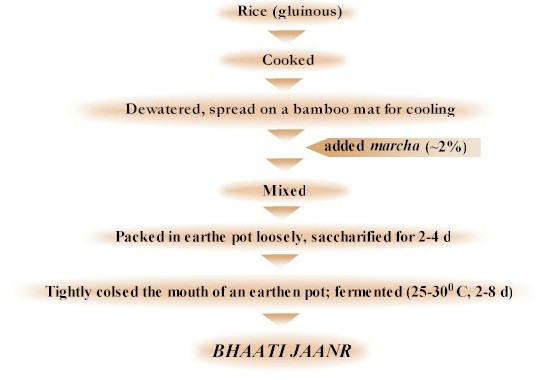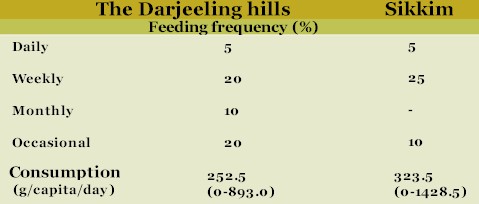| TRADITIONAL
FERMENTED FOODS AND BEVERAGES OF
THE SIKKIM HIMALAYAS |
 |
Bhaati
jaanr is a mild-alcoholic and juicy soft product with distinct
sweet aroma, prepared from steamed glutinous rice. Bhaati jaanr is a Nepali
word for fermented rice beverage. Different ethnic people call it by their
own dialect such as tak thee (Limboo), kok umaak (Rai), kaiyan paa (Gurung), kaan chi (Tamang), kameshyaabu (Sunwar), chho
haan (Magar), ja thon (Newar), dacchhang (Sherpa), laayakaa chhyaang (Bhutia),
and jo chee (Lepcha).
|

|
|
During
traditional method of bhaati
jaanr preparation, mainly glutinous rice, is cooked for about
15 min in an open cooker. Excess water is drained off and spread on a
bamboo mat called mandro for cooling (~ 40° C). Powdered marcha (1 to 2 %) is sprinkled over cooked rice, mixed
well and kept in a vessel or an earthen pot for 1-2 days at room
temperature for saccharification. During saccharification sweet aroma is
emitted out. After saccharification, the vessel is made airtight and
fermented for 2-3 days in summer and 7-8 days in winter (Fig 9).

Fig. 9. Flow sheet of Bhaati jaanr preparation in South
Sikkim
|

|
 |
Bhaati jaanr is made into a thick paste by stirring the ferm ented mass with the help of a
hand-driven wooden or bamboo-made stirrer. It is consumed directly.
Sometimes, bhaati jaanr is stored
in an earthenware crock for a week or more after desired fermentation is
completed to make yellowish-white supernatant liquor called nigaar,
collected at the bottom of the earthen ware crock. Nigaar is drunk directly with or without addition of
water. It is more
alcoholic and slightly acidic in taste. It is a traditional diet for new
mothers in villages who believe that it helps them to regain their strength. ented mass with the help of a
hand-driven wooden or bamboo-made stirrer. It is consumed directly.
Sometimes, bhaati jaanr is stored
in an earthenware crock for a week or more after desired fermentation is
completed to make yellowish-white supernatant liquor called nigaar,
collected at the bottom of the earthen ware crock. Nigaar is drunk directly with or without addition of
water. It is more
alcoholic and slightly acidic in taste. It is a traditional diet for new
mothers in villages who believe that it helps them to regain their strength.
Feeding frequency of bhaati
jaanr is presented in Table 4. Only 5 % of people consume bhaati jaanr daily in rural areas of the Sikkim Himalayas. Per
capita daily consumption of bhaati
jaanr in the Darjeeling hills and Sikkim is 252.5 g and 323.5 g,
respectively (Tamang et al.,
1996).
|

|
|
Bhaati jaanr is similar to other fermented rice products of Asia such as tapé ketan of Indonesia), lao-chao of Cantonese in China, tien-chiu-niang of Mandarin in China, yakju of
Korea and khao-maak of Thailand.
|
|